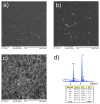Development of β Type Ti23Mo-45S5 Bioglass Nanocomposites for Dental Applications
- PMID: 28793695
- PMCID: PMC5458847
- DOI: 10.3390/ma8125441
Development of β Type Ti23Mo-45S5 Bioglass Nanocomposites for Dental Applications
Abstract
Titanium β-type alloys attract attention as biomaterials for dental applications. The aim of this work was the synthesis of nanostructured β type Ti23Mo-x wt % 45S5 Bioglass (x = 0, 3 and 10) composites by mechanical alloying and powder metallurgy methods and their characterization. The crystallization of the amorphous material upon annealing led to the formation of a nanostructured β type Ti23Mo alloy with a grain size of approximately 40 nm. With the increase of the 45S5 Bioglass contents in Ti23Mo, nanocomposite increase of the α-phase is noticeable. The electrochemical treatment in phosphoric acid electrolyte resulted in a porous surface, followed by bioactive ceramic Ca-P deposition. Corrosion resistance potentiodynamic testing in Ringer solution at 37 °C showed a positive effect of porosity and Ca-P deposition on nanostructured Ti23Mo 3 wt % 45S5 Bioglass nanocomposite. The contact angles of glycerol on the nanostructured Ti23Mo alloy were determined and show visible decrease for bulk Ti23Mo 3 wt % 45S5 Bioglass and etched Ti23Mo 3 wt % 45S5 Bioglass nanocomposites. In vitro tests culture of normal human osteoblast cells showed very good cell proliferation, colonization, and multilayering. The present study demonstrated that porous Ti23Mo 3 wt % 45S5 Bioglass nanocomposite is a promising biomaterial for bone tissue engineering.
Keywords: 45S5 bioglass; etching; nanocomposite; powder metallurgy; surface properties; titanium.
Conflict of interest statement
The authors declare no conflict of interest.
Figures










References
-
- Rack H.J., Qazi J.J. Titanium alloys for biomedical applications. Mater. Sci. Eng. C. 2006;26:1269–1277. doi: 10.1016/j.msec.2005.08.032. - DOI
-
- Geetha M., Singh A.K., Asokamani R., Gogia A.K. Ti based biomaterials, the ultimate choice for orthopedic implants—A review. Prog. Mater. Sci. 2009;54:397–425. doi: 10.1016/j.pmatsci.2008.06.004. - DOI
-
- Kim S.E., Lim J.H., Lee S.C., Nam S.C., Kang H.G., Choi J. Anodically nanostructured titanium oxides for implant applications. Electrochim. Acta. 2008;53:4846–4851. doi: 10.1016/j.electacta.2008.02.005. - DOI
-
- Okuno O. Titanium alloys for dental applications. J. Jpn. Soc. Biomater. 1996;14:267–273.
LinkOut - more resources
Full Text Sources
Other Literature Sources
Miscellaneous

